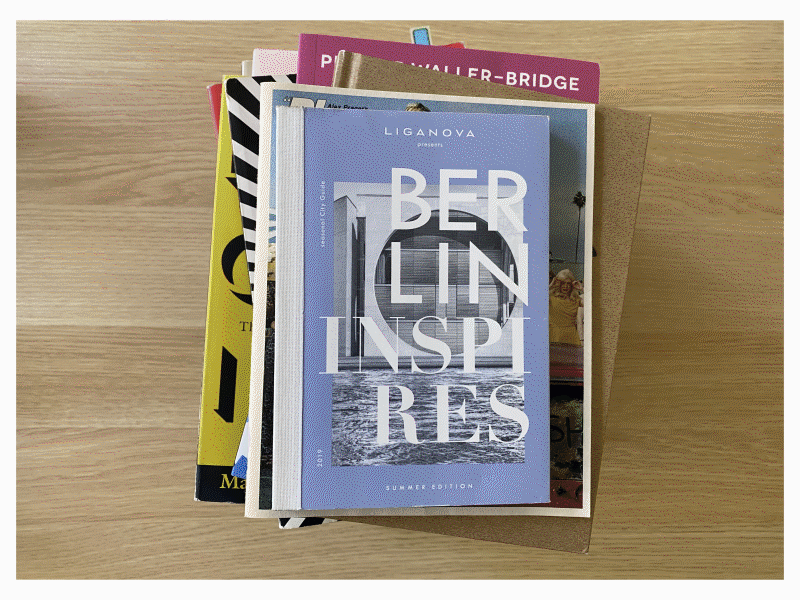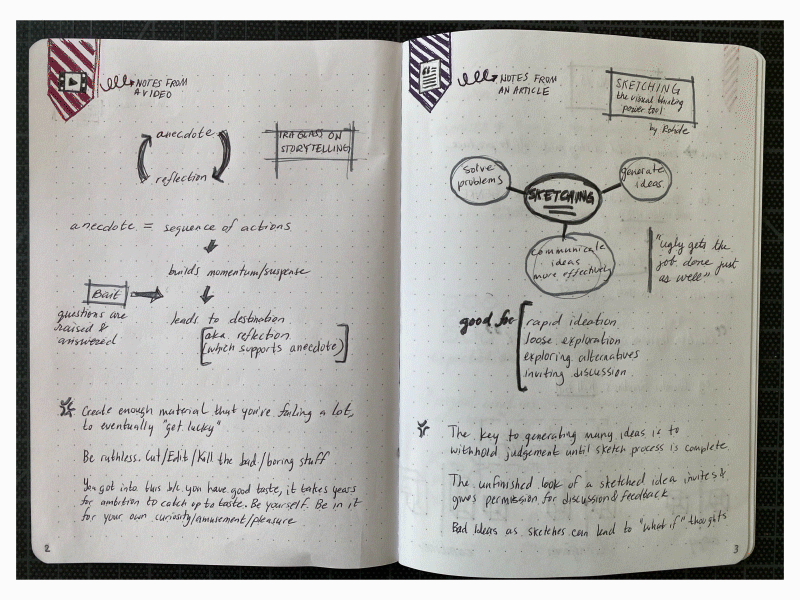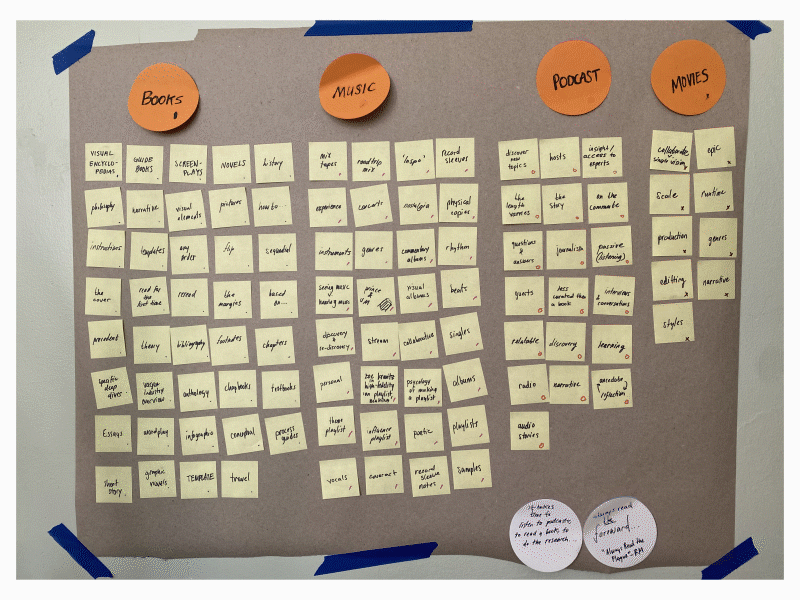00_Ideation and Brainstorming
A QUICK INTRODUCTION
A process documentation of my capstone project for NYU Integrated Digital Media Master’s.
Young’s 5 Steps for Producing Ideas
James Webb Young explains five steps for producing ideas. This is a method I applied to this project phase of ideation. Below you’ll find the five steps and how they correlate to the methods and practices I used.
Gather Raw Material
- personal inventory
Think. Digesting Material
- word lists
- mind maps
- note taking
Relax. Unconscious Processing
- going for a walk
- watching a movie
- browsing the public library
AHA! Eureka Moment
- realizing the potential of my personal project
- writing down my initial ideas
Rework. Ideas meet reality.
- this is upcoming…
- prototyping
S.C.A.M.P.E.R
This concept resolves around the idea that no single idea is entirely original. New ideas are derived from old ideas. Right now I just have the questions input into this miro board, but as I get closer to the first draft I’ll use the SCAMPER method further develop the concept
PERSONAL INVENTORY
Without realizing it, I’ve done a personal inventory quite a few times since starting these courses in anticipation for the capstone project. During quarantine, I think like most people I reorganized my belongings countless times, probably in an attempt to be in control of any aspect of my life. But one of the things I went through very meticulously was my book collection. I shaved down my books by almost half, keeping only the ones that held significant meaning to me, that I used and referenced regularly, and that I intended to read (or read again) in the near-ish future. This left with me with a collection that sparks my interests, some very specific books on niche subjects and a collection that I was actually interested in and proud of. I found myself browsing my own, now curated collection more frequently.
These are few of the books I’ve been reading recently. But I also sorted though my records and here’s some of what I’ve been listening to the last couple weeks…
And lastly, just in case you need to see how helpful it is to be repetitive, here’s a written list of things that have specifically sparked my interest. (Note: This doesn’t include movies or artists as the list was too extensive to dive into.)
Word List to Mind Maps
This word list, in addition to personal inventory, helped me narrow done to topics to things I was interested in. A theme that keeps coming up for me is movies and instructional guides.
THEN BACK TO “STUDYING” AND NOTE-TAKING
So many notes actually. I was thoroughly exploring every link, watching every video, and deep diving into inspiration and collecting influences. Listening and reading to people sort through and make sense of their own process and their own collection of influencers (god I hate that word now).
My notes were detailed. Some of this was familiar to me, but I think spending so much time in this phase resulted in a deeper understanding, fascination, and appreciation for the creative process and honestly helped in me unlocking my own.
Using some of the methods discussed in week 1, I doodled my heart out, well kinda. I mostly adopted a bullet journal type of format of note-taking. Hoping this would help me organize my thoughts and inspire me to go back and actually read them. The other thing I did was; intentionally writing down ideas and moments of reflection on the topic as they were popping into my head.
Collecting General Knowledge
Questlove also comments about this collecting of general knowledge though he phrases it differently, he talks about just absorbing inspiration a majority of the time and creating new work only a fraction of the time. This resonated so much with me…I always do this.
But it’s also through reading, listening to music, and so many other things that I gather and collect this inspiration, influence, and general knowledge. Specifically, recently reading about movies more. And tracking the movies I’ve been watching. Obsessively creating a spreadsheet. At first it was going to be some infographics about data on all the movies I’ve watched in a year, but the ideas have morphed into other things. Right now it’s just about collecting data on these movies so I have a large body of data to work with. I’m only adding movies as I’m watching them or rewatching them.
Now it’s almost a game for me, this year I’ve now seen all of Wes Anderson’s movies and I’ve realized how many of Steven Spielberg’s movies I love and also seen, but also how many of his movies I haven’t seen. And Hayao Miyazaki, but I’m also discovering a lot of new movies and directors by doing this.
I’ve been watching film maker’s movies chronologically, as best as I can, to see how they progressed in their skill and style. This is a personal project I’ve started and realize the potential of the data I’m collecting on them.
Something I’ve realized in this endeavor is that the suggestions for movies are based on similar genres and other works by the same director or in some cases actors, but that is lacking is a suggestion for precedent and inspiration for these films. Sometimes that’s more interesting than watching a film in the same genre. It’s about discovery and takes quite a bit of research to find these examples.
Methodology
Below you will find an image of my capstone journal that gives an overview and reflection for the process I followed for ideation.
Combing a few methods from “Universal Methods of Design: 100 Ways to Research Complex Problems, Develop Innovative Ideas, and Design Effective Solutions" by Bella Martin and Hanington for this method of ideation. Using practices similar to affinity diagramming and mind mapping a series of word lists, clusters, connections, and patterns.
Initial Project Concept
To give suggestions and recommendations based on the influence and inspiration of the movie creators / directors. Most suggestions are based on similar genres and not exactly what I’m looking for. A database which can lead to an algorithm to make the suggestions or even a browser plug-in that alters on site suggestions to follow this algorithm instead.
If not an algorithm based product, an option is a compendium that can be scaled to be just about one movie, the work of one director, or about a franchise or collection. Another option is to create to a truly multimedia playlist; that might include plays, books, movies, songs, etc. The other goal is to make this interactive so it’s not just a list of source material, this will hopefully replicate following a nonlinear path of discovery that is so enthralling about doing your own research.
The other main goal is building and sharing a “inspiration lineage” for movies.
Next Steps:
Write a refined concept / problem statement
Collect / gather images to make 3 mood boards
Answer questions for project proposal
Kirby Ferguson’s 4 Steps to Get an Idea
Once I settled into the idea of movie lineage, I used Ferguson’s steps to develop my ideas for this concept.
Set Boundaries
- Possible scales for this project revolve around doing the research for a single movie (i.e. Kill Bill Vol 1 & 2), a director (i.e. Wes Anderson), or a collection or franchise of movies (i.e. James Bond).
- I’m limiting my research to those films to see the types of content and data I can collect in the three week time frame.
- I’m not limiting my influences to these films
Consume Everything
- read a whole bunch of blogs and articles
- watched video essays
- checked out misc. books from the library
- see annotated bib for these sources
Digest Research
- making sense of the information lead me to decide to develop a prototype around one movie
- started by building a spreadsheet to find patterns in the data
Drop it













